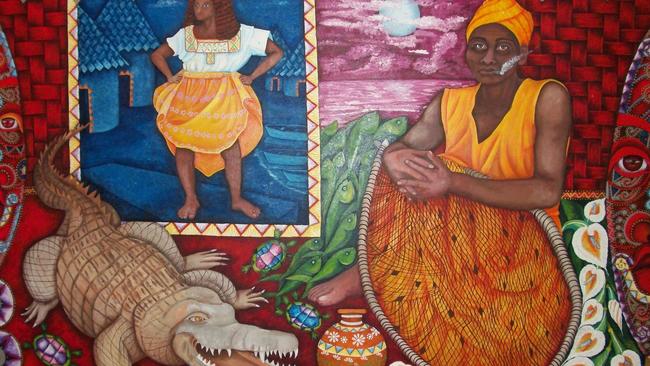An exhibition now under way in Tijuana displays a sliver of Mexico’s art and culture that rarely gets much attention in Mexico, let alone beyond it: paintings of Mexico’s Cimarron (“maroon” in Spanish), or black Mexican, population, done by an artist from that region.
The works, which will be shown until Aug. 31 for free at a border-front Tijuana art gallery called Casa del Tunel Art Center, come from Oaxaca’s Costa Chica, a region in southwestern Mexico where the country’s black population has lived for generations, said curator Rashad Salahuddin, who goes by Brother Rashad in his curation work.
The exhibition shows art by Ivaan Hernandez Piza, who grew up in a town called Collantes and who paints scenes and people from the Costa Chica.
Hernandez Piza’s work is representative of the style of art from the region, particularly in the way it uses different media and materials. His works are on canvas, calabash gourds and coconut pods, Salahuddin said. Their subject matter also reflects their setting, as the scenes he paints show life from the community.
He described, in an email, a work that is “essential to representing the heritage, ancestry and history of his pueblo of Collantes.” The painting, “Juego De Pelota Cimarrona” (“Maroon Ball Game”), shows a man in the middle of playing the Olmec ball game. The game was played by the pre-Columbian Olmec people, who lived on the Gulf of Mexico’s southern coast. In the painting, the man’s arms are outstretched, a ball is hurtling toward him, and in the background there is a large Olmec head.
Salahuddin said Collantes “has been noted as having the longest-living continuous history of playing a variation of this ancient Olmec ball game within Mexico.”
Hernandez Piza’s works are important because they reveal art about a rarely seen part and people of Mexico, the black Mexicans, Salahuddin said.
Dubbed “Oaxaca Negra,” the show is “a celebration of that continuing presence and that ethnic designation that still remains here,” Salahuddin said.
“Continuing” is worth noting because until recently, Mexico’s blacks, descended from slaves, struggled to gain official, government-recognized status. Their count is around 1.4 million, according to a 2015 Mexican census survey.
Hernandez Piza was born in 1983, the artist wrote in a brief autobiographical profile. He wanted to paint as a boy but only got the chance when he was an adult. One day, walking home, he saw some young people painting in a workshop. The supervisor invited him to give it a try, and from there he began painting with various instructors.
Since then, his work has been shown around Mexico, including several times in Mexico City and on the cover of an anthropology book.
Casa del Tunel collaborates with the WorldBeat Cultural Center in Balboa Park. Makeda “Dread” Cheatom, the center’s founder and executive director, said the exhibition is significant because it creates more pride in that population: “Because that presence has been there, but no one knows,” Cheatom said.
“Oaxaca Negra: Cimarron Art from the Costa Chica”
When: Through Aug. 31
Where: Casa del Tunel, 133 Chapo Marquez Colonia Federal, Tijuana
Tickets: Free
Phone: (619) 230-1190 (WorldBeat Culture Center)
Online: facebook.com/CasaDelTunel/





